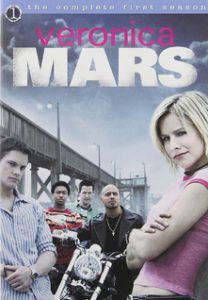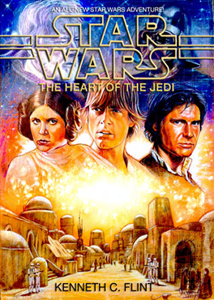Kenneth C. Flint’s “The Heart of the Jedi,” written in 1992, was originally published on starwarstimeline.net in 2015. But it received new attention in recent months with its bootleg paperback printing and Amazon listing, which didn’t last long until Disney understandably pulled it down for copyright infringement. But it can be read online, where it is published under creative commons law.
This is one of the most famous canceled “Star Wars” novels, mainly because it’s the only one that has surfaced. Hopefully the buzz among Expanded Universe fans over the bootleg didn’t go unnoticed, and maybe Disney will actually publish some of these in the future.
Since canceling the Legends timeline, Disney has published one new work – Marvel “Star Wars” Issue 108 (2019) – and recently it collected some Legends short stories from Star Wars Insider. But Disney canon stories are also in that collection, dampening Legends fan enthusiasm.

“The Heart of the Jedi” (2015)
Composition year: 1992
Author: Kenneth C. Flint
Series: “Star Wars” Legends (canceled novel)
Some good things, some bad
OK, on to “Heart of the Jedi” as a book. It’s much more of a curiosity than it is a good read, which is a little surprising because Flint’s “Tales from the Mos Eisley Cantina” and “Jabba’s Palace” shorts are strong. But the fact that it didn’t get the full editorial treatment from Bantam Spectra should be considered.
Set between “The Truce at Bakura” and “Luke Skywalker and the Shadows of Mindor,” it flows like that “Glove of Darth Vader” children’s series in its weakest moments. Flint does a thing where he rapidly jumps between groups of people – for example, an Imperial bridge and a competing New Republic ship – within a single battle.
But the author does some things well, and presages some Legends events. He writes C-3PO poorly in general, but he does come up with a great subplot where the droid’s mind is wiped. Threepio is temporarily a bad guy and then temporarily a personality-free machine.
Flint’s use of an Ewok as a pirate-ship captain ally of Luke is a lot of fun. Don’t worry, there’s a good explanation for how the eyepatch-wearing Thatch is different from others of his race – one that I guessed right away but that didn’t hamper my enjoyment.
Luke’s internal struggle
Broadly, Flint does a good job of writing Luke, who seeks the Heart of the Jedi, a powerful gem on a remote world that calls to mind “Splinter of the Mind’s Eye” and the “Clone Wars” Mortis trilogy.

He’s caught between his identities as “Luke” and “the last Jedi Knight,” and articulates this particular strife better than in most Legends yarns. Luke is self-aware about being thrust into the galactic war without having much time to think about it.
But the author writes Luke poorly in specific instances. Despite being a commander in the Alliance, he’s ignorant about things he shouldn’t be, such as the type of Imperial craft he and Thatch encounter.
Flint’s excursion to Tatooine is enjoyable, calling to mind novels like “Tatooine Ghost” and “Kenobi.” Luke’s encounter with a Tusken Raider camp is thrilling, his visit to the Lars and Kenobi homesteads are nostalgic, and his card game against Ponda Baba is fun.
A delicate editing pass
Although starwarstimeline.net’s Joe Bongiorno took an editing pass to make “Heart” fit after “Truce at Bakura” (rather than in “Truce’s” place in the immediate wake of “Return of the Jedi”), the novel ideally would get another punch-up if it were to be officially published.
For example, the cantina is generically called “the Mos Eisley cantina” rather than Chalmun’s. And the card game isn’t sabacc, but something more like an Earth game.
That said, I appreciate that Bongiorno aimed to preserve Flint’s original work and not meddle beyond the timeline placement and basic logic issues. For instance, in Flint’s draft, shapeshifters are unheard of among the Empire, but after Bongiorno’s fix, Imperials are aware of Clawdites (see Zam Wesell) and Shi’ido (the “Galaxy of Fear” books).
Underexplored ideas
Flint touches on some ideas that could’ve been explored more deeply. Some Imperials – including surviving members of the Old Republic Senate, from when it was disbanded – want peace. I’d be interested to learn more about these people.
Others, including main villain High Admiral Tharkus, see the confusion after the Battle of Endor as a chance to grab power. Compared to other warlords of this time (such as Zsinj from the “X-wing” books), Tharkus is blandly evil. In Flint’s defense, he wrote this at a time when the only novel of the “Star Wars” popularity resurgence was Timothy Zahn’s “Heir to the Empire.”
While there weren’t a lot of materials to draw from, Flint did his research. Leia is not a strong swimmer, a nod to “Splinter of the Mind’s Eye.” And the author (or perhaps Bongiorno) references the Alliance’s skirmishes against alien races from late in the Marvel comics.
“Heart of the Jedi” has the bones of a good novel, and could’ve gotten there had it gone through the whole editing process. So it’s unfair to compare it with the official releases that got the full treatment.
And heck, even in its current state, it’s better than the weakest EU works, such as “The New Rebellion.” Die-hard Legends fans should check it out on starwarstimeline.net.

